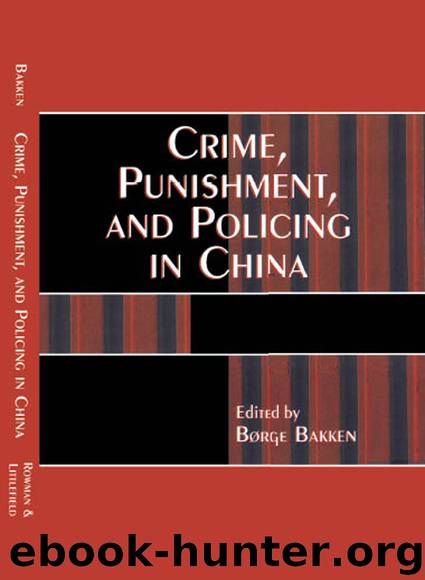Crime, Punishment, and Policing in China by Bakken Børge

Author:Bakken, Børge.
Language: eng
Format: epub
Publisher: Rowman & Littlefield Publishing Group, Inc.
Published: 2007-03-06T16:00:00+00:00
CARCERAL SPREAD
Incarceration in China is divided into two forms: the detention sector and the prison sector. Unlike the prison sector, detention falls within the purview of the Ministry of Public Security. Unlike Western lockups and watch-houses, Chinese detention centers can hold more than just suspects; they can also hold convicts. Three types of detention centers exist. These are the juyisuo which are like local jails, the jiuliusuo which are like city versions of the jiyisuo, and the kanshousuo which are like a watch-house or lockup. There is a huge overlap in their responsibilities and all three tend to be used both as lockups and jails. Indeed, convicted criminals on minor offences that are sentenced to two years or less of incarceration can actually end up doing their time in the jiuyisuo rather than the prison. Generally, however, such centers are used to detain those who have been charged but not yet convicted. Detention in the jiuyisuo runs from fifteen days to half a year. In the juliusuo, suspects are generally held for no more than fifteen days, while in the kanshousuo they can be held for up to ten days prior to charges being laid, and then three months if charged.63 Apart from this form of short-term detention, there are also other forms of incarceration that lie outside the prison sector proper. These are for people who have committed no breach of the criminal code but whose actions or attitudes are in breach of certain administrative regulations. There is, then, a distinction between administrative and criminal detention.
In Chinese law, there are two types of detention: one is administrative detention, where the detainee receives labor education in a reform-through-education institution, while the other is criminal, and the prisoner undergoes labor reform within the prison sector proper. Since 1983, both the prison and the reform-through-education institutions have operated under the Ministry of Justice. The differences between the prison and reform through education are, in theory at least, quite significant. Actions that warrant detention for labor education are those which are regarded as insufficient to warrant a criminal charge being laid but serious enough to require “transformation.”
Criminals have penalties imposed by the courts on the basis of the criminal code and sentences can range from between one year to life imprisonment. Generally, within the prison sector, those incarcerated for ten years or more or those regarded as “sensitive prisoners” go to prison, while light offenders go to prison camps.64 In contrast, labor education is a noncriminal administrative sanction imposed by a reform-through-education management committee, and while it leads to punishment, it does not result in a criminal record. The administrative regulations allow sentences of up to three years, with a possible fourth year extension. Sentences are imposed by a reform-through-education management committee that is made up of people from the local Party and government, the procurate, and the police. The history of reeducation through labor is different from reform through labor insofar as it emerged from a different set of needs and at a different time than the prison sector.
Download
This site does not store any files on its server. We only index and link to content provided by other sites. Please contact the content providers to delete copyright contents if any and email us, we'll remove relevant links or contents immediately.
| Africa | Americas |
| Arctic & Antarctica | Asia |
| Australia & Oceania | Europe |
| Middle East | Russia |
| United States | World |
| Ancient Civilizations | Military |
| Historical Study & Educational Resources |
The Sympathizer by Viet Thanh Nguyen(4284)
The Rape of Nanking by Iris Chang(4120)
World without end by Ken Follett(3413)
Ants Among Elephants by Sujatha Gidla(3393)
Blood and Sand by Alex Von Tunzelmann(3115)
Japanese Design by Patricia J. Graham(3089)
City of Djinns: a year in Delhi by William Dalrymple(2496)
The Queen of Nothing by Holly Black(2462)
Foreign Devils on the Silk Road: The Search for the Lost Treasures of Central Asia by Peter Hopkirk(2419)
India's Ancient Past by R.S. Sharma(2397)
Inglorious Empire by Shashi Tharoor(2383)
Tokyo by Rob Goss(2372)
In Order to Live: A North Korean Girl's Journey to Freedom by Yeonmi Park(2325)
Tokyo Geek's Guide: Manga, Anime, Gaming, Cosplay, Toys, Idols & More - The Ultimate Guide to Japan's Otaku Culture by Simone Gianni(2302)
India's biggest cover-up by Dhar Anuj(2301)
The Great Game: On Secret Service in High Asia by Peter Hopkirk(2290)
Goodbye Madame Butterfly(2188)
Batik by Rudolf Smend(2099)
Living Silence in Burma by Christina Fink(2023)
